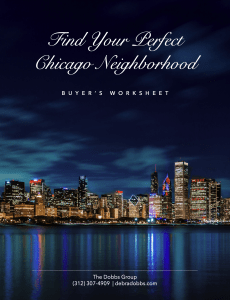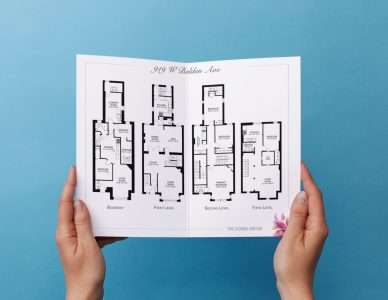Choosing the Right Neighborhood: A Buyer’s Essential Checklist
Buying a home is one of the biggest decisions you’ll make, and choosing the right neighborhood is just as important as finding the right house. Especially in today’s fast-moving market, where inventory is often tight, you don’t always have the luxury of hesitation. When the right home appears, you need to be ready to act quickly—but that doesn’t mean skipping your research.
The key to making a confident decision under pressure is understanding your target neighborhoods inside and out before you even start house hunting. Whether you’re a first-time buyer or moving within the city, this checklist will help you evaluate and compare your preferred neighborhoods so you can move forward with certainty when the right opportunity comes along.
1. Daily Life: Will This Neighborhood Fit My Routine?
□ How long will my commute be? – Test your drive, bike route, or public transit options during rush hour—not just on weekends.
□ Are grocery stores, restaurants, shops, pharmacies, and other essentials nearby? – Look beyond Google Maps; visit in person to see how convenient daily errands will be.
□ What’s the parking situation? – If you own a car, find out about street parking, permit requirements, or garage availability or is deeded parking a ‘must have’?
□ How is traffic flow in and around the neighborhood? – Some areas get gridlocked at certain hours—visit at different times of the day.
□ Are there sidewalks, bike lanes, or easy walkability? – If walkability matters to you, test how accessible parks, shops, and restaurants are on foot.
2. Schools & Education: Will This Area Work for My Family’s Needs?
Even if you don’t have kids, school districts impact home values and resale potential. If you do have children (or plan to), schools should be a top consideration.
□ What school district is this home in? – Verify with the school distrectly, as boundaries can change.
□ How do local schools rank? – Look at test scores, reviews, and student-teacher ratios (but remember, rankings don’t tell the full story).
□ Are there good private or charter school options nearby? – If you’re considering alternatives to public schools, check for accessibility and tuition costs.
□ What’s the school commute like? – Test the route during drop-off and pick-up hours.
□ Are there parks, libraries, and kid-friendly activities nearby? – A neighborhood with family-friendly infrastructure often has a stronger sense of community.
3. Market Trends: Is This a Smart Investment?
□ Are home values in this neighborhood increasing, stable, or declining? – Look at historical price trends, not just current listing prices.
□ Are there signs of new development or revitalization? – New businesses, infrastructure, or investments often indicate future growth.
□ What’s the typical price per square foot in this area? – Compare to nearby neighborhoods to gauge value.
□ How competitive is this area? – Ask your agent about average days on market and whether homes often sell above asking price.
□ Are there upcoming zoning changes or major projects planned? – Large-scale developments can impact home values positively or negatively.
4. Lifestyle & Community: Will I Feel at Home Here?
□ What’s the overall vibe of the neighborhood? – Walk around at different times of the day to get a sense of the atmosphere.
□ Are there restaurants, coffee shops, or entertainment spots nearby? – If you love going out, look for areas with an active social scene.
□ What kind of community activities happen here? – Farmer’s markets, festivals, and neighborhood events indicate a strong local culture.
□ How diverse is the housing stock? – If you’re looking at condos but may want a single-family home in the future, check if the area has options for long-term growth.
□ Are there parks, green spaces, or waterfront access? – If outdoor space matters to you, check for trails, dog parks, and public recreational areas.
5. Pet-Friendly Living: Is This Neighborhood Right for My Furry Friend?
□ Do we need a garden? Are there nearby pet-friendly outdoor areas? – Check for off-leash areas, trails, and dog-friendly parks.
□ Are pets allowed in condos or apartment buildings? – Many buildings have breed or weight restrictions—always verify before buying.
□ How pet-friendly are local businesses? – Some neighborhoods have dog-friendly cafes, groomers, and pet supply stores.
□ Are there veterinarians, pet stores, and emergency animal hospitals nearby? – Easy access to pet care is a must.
□ Is the neighborhood noisy or high-traffic? – If you have a sensitive pet, consider the stress levels of a busy environment.
□ Do neighbors seem to have pets? – A pet-friendly neighborhood often means more relaxed policies and better pet amenities.
6. Practical Considerations: Are There Any Deal Breakers?
□ Is there a homeowners association (HOA), and what are the rules? – Some HOAs have strict rules on exterior changes, rentals, and even holiday decorations.
□ Are there any noise factors to consider? – Check for nearby train tracks, major roads, or nightlife spots that could impact your quality of life.
□ How accessible is public transportation? – If you don’t plan to drive everywhere, check for frequent bus/train service.
□ What’s the property tax rate in this area? – Taxes can vary widely and impact long-term affordability.
□ Will this neighborhood still work for me 5–10 years from now? – Think about long-term plans and whether this area aligns with your future lifestyle.
7. Talk to Locals: Get Insider Knowledge
□ What do current residents love most about living here? – Ask neighbors or browse local forums for real-life perspectives.
□ What’s something people wish they knew before moving here? – A great way to uncover hidden downsides.
□ What are the biggest pros and cons of this area? – No neighborhood is perfect, but knowing the trade-offs helps you make an informed choice.
Be Ready Before the Right Home Hits the Market
Once you’ve answered these questions for the neighborhoods you’re considering, you’ll be prepared to make a fast, confident decision when the right home becomes available. In a low-inventory market, the buyers who have done their research ahead of time are the ones who win.
After 41 years in real estate and having lived in several Chicago neighborhoods myself, I know how important it is to feel confident in your choice—both in your new home and in your new neighborhood! I’ve helped countless buyers navigate this process, weighing the trade-offs and uncovering details that don’t always show up in listings. If you need help narrowing down neighborhoods or want insights beyond the usual market data, I’d love to share what I’ve learned over the years. Let’s find the right place for you!






